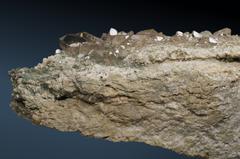last modified: Wednesday, 27-Apr-2011 22:58:29 CEST
Document status: work in progress
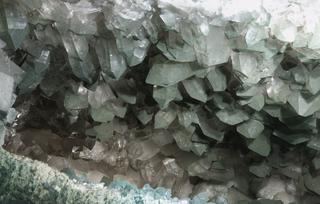
|
Alpine-type fissures have first been exploited, studied and described in the European Alps, so they are often simply called "Alpine fissures". But they occur in other mountain chains, as well, for example the Himalayas and the Ural mountains. An "Alpine fissure in the Himalayas" sounds very odd, so I refer to them as alpine-type, and not as "Alpine".
For centuries alpine-type fissures have been the main source of quartz crystals for lapidary and ornamental uses. While pegmatite deposits took the lead as major source of rock crystals and pure quartz, the best smoky quartz still comes from alpine-type fissures. To the quartz collector, alpine-type fissure specimen are not only attractive because of their beauty but also because the relationship between the different quartz habits and forms and the growth conditions have been studied in detail.
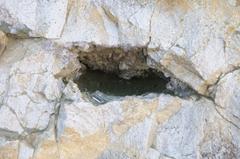
|
The photo has been taken in upper Val Giuv, Eastern Aar Massive, Tujetsch, Graubünden, Switzerland.

|
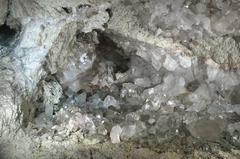
|

20mm 2240x1434 368kb |

|
Formation, Occurrence and Types of Fissures
Alpine-type fissures can only form under special conditions that are not easily met. They form when rocks get folded or sheared at great depths and at relatively high temperatures, between 200° and 600°C. Under these conditions the rocks are still solid, but malleable, so they do not shatter when they get deformed slowly. The rocks must still maintain some degree of rigidity and may not be too ductile, otherwise fissures would not open. It is favorable that the rock has a layered structure like gneiss or schist, but this is not a requirement.
-
rocks experience strain in one direction, or experience stress that varies in different directions.
The resulting fissures are roughly lens-shaped and called extension fissures.
-
rocks experience shearing.
The resulting fissures often have a sigmoidal shape. In German-speaking literature on Alpine geology these are called "Scherkluft", and as I could not yet find an official English term for them, I will simply translate this and call them shearing fissures.
Alpine-type fissures may assume many different shapes, but in general they tend to form flat cavities, with relative dimensions between about 5 by 2 by 1 and about 10 by 3 by 1, so they are long cavities that are about two to three times as wide as high. In igneous rocks the fissures are a bit higher, in mica shists they are often very narrow. Their orientation depends on the direction of the tectonic forces and the direction of the layering of the rocks:
- The fissures open parallel to the direction of the biggest stress and perpendicular to the direction of the net strain.
- If there is a layering in the rocks (in gneisses, mica shists, phyllites, slates, mylonites), then the fissure runs roughly perpendicular to it. Very close to the fissure the layering of these rocks is often distorted.
Most fissures do not open completely all of a sudden, they widen gradually, and minerals attached to both walls might develop special growth forms. A typical growth form of quartz that can often be found in alpine-type fissures is faden quartz.
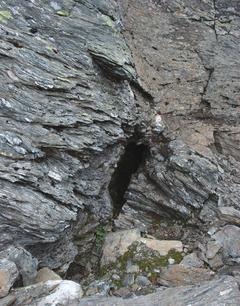
|
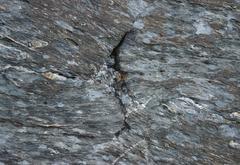
|

|
The opening of fissures is promoted wherever the homogeneous structure of the host rock is mechanically disturbed, for example at the border to another type of rock or at aplite dikes and pre-existing quartz veins that run through the rock. For that reason, alpine-type fissures are often closely associated with quartz veins that are older than the fissure.

|

|
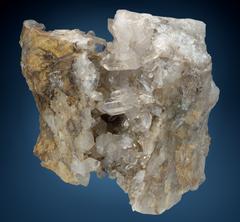
20mm 1080x1000 170kb - 2160x2000 478kb |

|
Fig. 2.6 shows a single large boudin structure that formed in a shist, the diameter of the competent center is about 1 meter. The photo was taken at a road cut between Gletsch and Oberwald, Wallis, Switzerland, an area with a lot of alpine-type fissures. Since rocks of different competence are usually aranged in layers, such boudin structures often form chains.

|
Very often a gap will remain between two boudins and alpine-type extension fissure develops. It is very likely that there was once a small pocket at the neck of the hourglass that was opened and exploited while the road was built.

|
While boudinage in the strict sense (as shown in Fig.2.6 and Fig.2.7) can be found in many different types of rocks, the inward pinching around an alpine-type fissure can only be observed in rocks with a shist-like structure and layering, it is absent in granitoids or sandstones, for example.

|
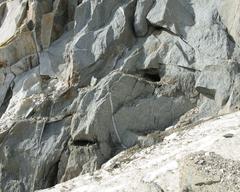
|
It might seem a bit far-fetched to claim that the formation of both fissures is linked in some way, but just as shown in Fig.2.9, alpine-type fissures open in localized zones of shearing and extension of rocks, they are not randomly distributed. Local rockhounds often check the relative position of old and emptied fissures and look for such patterns to find zones in the rock that were stretched.
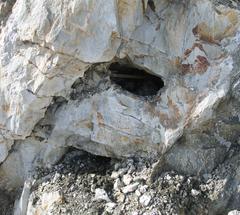
|
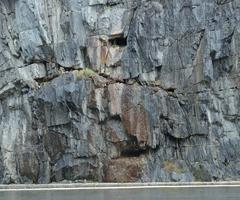
|

|
In the Alps, there is a story about two groups of rockhounds who met each other inside a fissure they have been working on from both ends, not knowing of each other's activities. So fissures are generally very narrow, but they can get very long.
Localities
- European Alps (Austria, France, Italy, Switzerland)
- Wales
- Dingle Peninsula (Ireland)
- Madagascar
- Gamsberg (Namibia)
- Urals, Russia
- Japan
- Rhodopes (Greece)
- Pamir, Pakistan
- Himalayas (Nepal, India)
- Muzo, Andes, Colombia
- Quebec, Canada
- Rheinisches Schiefergebirge and Ardennes (Germany, Belgium)
- Southern Kaledonies (Norway)
- Appalachian Mountains (North Carolina)

|
The photo shows a classical locality of alpine-type fissure minerals: The Grimsel area and the central part of the Aar Massive. The Aar Massive, the Gotthard Massive and the Mont Blanc Massive are old crystalline mountain chains made of granitoid rocks that predate the formation of the Alps. The Aar Massive (named after the river Aare that has its source there) stretches roughly in westsouthwest-eastnortheast direction north of the Rhone and Rhine Rivers. In the center of the photo you see the Totesee lake at the Grimsel Pass, the zigzag line is the Grimsel Pass street winding up from the Rhone valley. The highest mountain of the massive is the Finsteraarhorn (4274 m), the deep valley to the left is the Rhone valley, which also marks the southern border of the massive. The photo has been taken from the Tällistock mountain at 2800 m altitude, viewing north-west.
If one looks at the world-wide distribution of alpine-type fissures, one may notice a close relationship to mountain ranges that formed during a collision of continental plates, so called alpine-type mountain ranges. Mountain ranges that formed during the collision of an oceanic and a continental plate, so-called Andes-type mountain ranges seem to be almost void of them. The favorite text book example for alpine-type mountain ranges are not the Alps (which are far too complex to be discussed briefly), but the Himalayas. In the list of known or suspected alpine-type fissure localities only Colombia and Japan are an exception - their mountain ranges are of Andes type. All the others are alpine-type mountain ranges, even if they have been mostly eroded, like the Urals or the Appalachian Mountains. In Andes-type collisions, the thin but heavy oceanic plate gets subducted under the continental plate, and the latter suffers only very little deformation during this process. A continental plate, on the other hand, has a relatively low average specific weight and thus cannot be subducted deeply into the denser mantle. As a consequence, the collision of continental plates leads to deformations at a large scale and intense folding and shearing of the continental crust, parts of which may even be overturned completely. One geomorphological feature is typical for alpine-type mountain ranges: the formation of nappes. Nappes are sheets of rock that have been pushed from their original position over other rocks where they for a continuous cover. This displacement is a response to intense folding and shearing of the crust.
Alpine-type Fissure Mineralizations
The distribution and mineralogy of alpine-type fissures has most extensively been studied and documented in Switzerland. Johann G. Koenigsberger has meticulously classified alpine-type fissures and distinguished about 115 different alpine-type fissure parageneses that occured in about 20 different types of deposits. His work has been summarized in the book "Die zentralalpinen Minerallagerstätten" ("The Central Alpine Mineral Deposits"), published in 1940, as part of the threepart book "Die Mineralien der Schweizer Alpen" by Niggli, Koenigsberger and Parker.Different from ore veins, in which minerals often precipitate from brines that originate in distant rocks of different composition, the minerals found in alpine-type fissures basically reflect the composition of the surrounding rock. For example, fluorite can only be found in alpine-type fissures that are surrounded by rocks that contain at least small amounts of fluorine. If certain minerals have been found in an alpine-type fissure, then other fissures in the same rock at that locality are likely to contain the same minerals. Which is not to say that the full set of minerals of a locality will be present in each fissure. Smaller fissures typically contain only the dominant minerals of a certain paragenesis, in particular the more "exotic" ones will be missing. In a sense this is sometimes also true for the different types of quartz that can be found at a locality: the bigger the fissure, the more likely gwindels are found, for example.
The rock composition has only a short-range influence on the mineralization. The upper Val Giuv, a valley in Graubünden, Switzerland, is a good example: the area is largely composed of an igneous rock locally called "Giuvsyenit" (actually much of it would be classified as a quartz monzonite in the QAPF diagram, and not as a syenite) that is cut by numerous aplitic dikes in random directions. Both contain alpine-type fissures, but the minerals in them differ: one can find actinolite and titanite in the pockets in the syenite rock, but not in the aplitic dike pockets, which instead sometimes contain the beryllium mineral milarite. If a fissure opens up between the aplite and the syenite, it may contain both types of minerals. Both will contain adularia feldspar and quartz, the latter tends to be much darker in the syenite because it contains more radioactive trace elements.
Although the host rock strictly determines the paragenesis of the fissures, the minerals found in the pocket are not necessarily the same as those in the rock. Val Giuv is again a good example: The "Giuvsyenit" is rather poor in quartz (on average about 5%, sometimes 0%). Nevertheless the paragenesis of the fissures is clearly dominated by quartz. The material for its growth was in part released during the alteration of the plagioclase feldspar which is not very stable at near-surface conditions and tends to decompose and which also suffered from the greenshist facies metamorphosis during the Alpine orogeny. Even rocks that lack quartz altogether may contain quartz crystals in the fissures, as long as the rocks are not undersaturated with respect to silica and do not contain minerals that would react with silica to form other minerals, like foids or olivine.
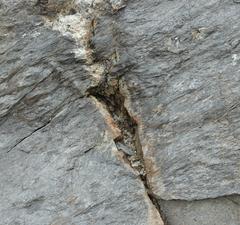
|
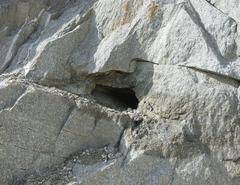
|
The area around the pocket is altered and looks darker than the fresh Giuv syenite. The darker color is probably due to weathering of plagioclase that tends to decompose into green minerals like chlorite and epidote (for comparison, see an altered granodiorite). Close to cavity the rock turns yellow-green and gets softer.

20mm 2080x1440 756kb - 4160x2880 2079kb |
Although numerous stubby smoky quartz crystals cover the wall, there is no macroscopically visible quartz in the host rock. Beside quartz, only very short, dark green actinolite fibers have grown into the fissure opening as a continuation of already present actinolite fibers in the rock. The white feldspar crystals were fractured when the fissure opened, like the actinolite, but only a few feldspar crystals grew a few millimeters into the pocket as adularia, in most cases the fracture surfaces have just healed to form regular crystal faces. This was probably a narrow fissure and it probably opened rather late, when temperatures where already too low to promote the dissolution and redisposition of the matrix feldspar to form adularia. In general, the rock walls around small alpine-type fissures tend to show very little alterations. Rock walls at narrow branches of larger fissures are usually just as altered as in wider parts of the fissure, though.
Something else is interesting, but difficult to see on the photo: Almost all quartz crystals sit on the host rock obliquely. Their c-axes are inclined around 40°-50°, but they point in random directions. This is a strong indication that the quartz crystals grew epitactically on the underlying elongated feldspar crystals that were aligned during the influx of the viscous syenite magma into the surrounding rocks. From the Terziana Muotta, Val Giuv.
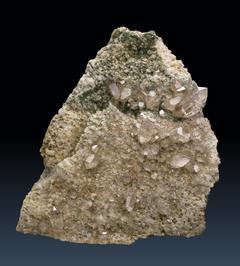
50mm 1600x1776 420kb - 3200x3552 1153kb
|
The second image is a close-up of the upper left corner, viewed from the left side. There are numerous cracks in the rock wall, some of them are filled with quartz, and all the dark minerals of the granite are gone. Found at an old fissure south of Piz Pali mountain, Val Mila, Tavetsch, Graubünden, Switzerland.
A little side note: Alpine quartz crystals show large variations in their look that may reveal their provenance to the initiated, in particular when they come with a matrix. When I showed this specimen to professional strahler Dosi Venzin, he just asked: "Val Mila?"

20mm 1728x1680 348kb - 3456x3360 1068kb |

20mm 2288x1472 480kb - 4576x2944 1345kb |
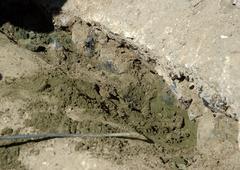
|
Quartz from Alpine-Type Fissures
It is difficult to narrow down the types of quartz to be expected in alpine-type fissures, and easier to count off what does not occur in them or is rare. One of the problems is that this compilation is mainly based on what is known from the European Alps, and there is very little literature on localities outside Europe. Another thing thing to keep in mind that some types of quartz are found in the Alps, but not in alpine-type fissures, for example the amethyst that occurs in so-called "Teiser Kugeln", geodes in volcanic rocks.
Varieties
Rock crystal is very common and only absent where it is replaced by smoky quartz.
Still the best smoky quartz comes from alpine-type fissures. It is very common in igneous rocks and derived metamorphic rocks.
In the European Alps amethyst is only found at few localities, the best of them in the Zillertal Alps in Austria. Amethyst from alpine-type fissure environments (including those from outside the European Alps) seems to occur exclusively as scepter quartz and related growth forms, often in combination with skeleton growth forms.
Citrine (with irradiation-induced color centers) is extremely rare in the European Alps. It has been found at very few locations in Austria and is otherwise unknown, and finds of citrine in the Alps are celebrated in collectors magazines. So far the color of Alpine citrine specimen has been found to be very pale.
Rose quartz and pink quartz are formed in pegmatite environments and do not occur in alpine-type fissures.
Ferruginous quartz that is evenly and deeply colored by inclusions of iron oxides or hydroxides is apparently absent in alpine-type fissures. Yellow crystals with thin superficial layers of goethite inclusions are occasionally found and have sometimes been mistaken for citrine.
Cryptocrystalline quartz varieties like chalcedony are definitely a rarity in alpine-type fissures. These are low temperature products that are associated with a chemically more unrest environment. The rocks around alpine-type fissures that cool to the appropriate temperatures for chalcedony formation have suffered a retrograde metamorphosis and the chemical reactions that could release the silica needed for chalcedony to form are steadily slowing down the colder it gets.
Growth Forms
Only one quartz growth form is apparently found exclusively in alpine-type fissures: the gwindel. Even here it is rare, and only found in certain environments, mostly weakly metamorphosed igneous rocks.
Since alpine-type fissures typically open and widen slowly, faden quartz is found, mostly in weakly metamorphosed sedimentary rocks like slates and phyllites.
Scepter quartz has already been mentioned as the typical growth form of amethyst from alpine-type fissures. Interestingly, smoky quartz scepters or smoky/amethyst scepters have not been found in the Alps, as far as I know.
Skeleton quartz is found at different localities. Amethyst scepters frequently show skeleton growth features, and rock crystal scepters with skeleton quartz growth forms on Tessin habit crystals have been found in the Binntal, for example. One locality is very famous for skeleton quartz, the Val D'Illiez at Monthey, Vallais, north of the Mont Blanc Massive, and the neighboring region around Bex, Vaud, north-east of the Val D'Illiez. The fissures occur in sandstones in Flysch rock, a series of sedimentary rocks with varying amounts of calcite, clay minerals and quartz. Similar specimen have been found in the Helvetian sedimetary rocks at the northern boundary of the central Swiss Alps, for example the Kiental valley, Bern, also mostly in Flysch rock (Stalder and Touray, 1970).
Split growth, both as sprouting or as artichoke quartz, is uncommon, in particular artichoke quartz seems to be absent. Artichoke and sprouting quartz do occur in the European Alps, for example the Val Bedretto and the Binntal valley, but come from hydrothermal veins, often associated with needle quartz.
Crystal Habits
Quartz from alpine-type fissures can occur in very different habits, and these seem to be in part dependent on the surrounding rocks and the conditions during formation. In Switzerland, for example, crystals of normal habit are found in the Aar and Mont Blanc Massif, while Tessin habit and transitional habit crystals occur in a zone south of the Rhone and Rhine valleys, mostly in phyllites, gneisses and mica shists (so-called Bündnerschiefer). Transitional habits seem to be more common in the Austrian Alps. Quartz from fissures in shists in the eastern areas of Graubünden contain Dauphiné habit and Muzo habit crystals that are absent in the areas where Tessin and normal habit crystals can be found. The "original" Muzo habit crystals from Colombia also came from alpine-type fissures.
Needle quartz is occassionaly found as individual crystals along with normal habit crystals that are slightly elongated, for example in alpine-type fissures at Tipling, Nepal. But aggregates of needle quartz that outline a cavity do not occur, as this type of needle quartz is indicative of fast growth, and crystals in alpine-type fissures grow very slowly. It should be noted that there is needle quartz from the Alps (the best known locality is the Val Bedretto in Ticino), but these crystals occur in a large hydrothermal vein.
Pseudocubic habit and Cumberland habit are apparently not found in alpine-type fissures.
Inclusions
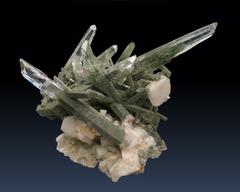
20mm 2000x1600 316kb - 4000x3200 883kb |
The photo shows a group of elongated, Dauphiné habit crystals with creme-colored pericline feldspar crystals on matrix. The chlorite inclusions are mostly confined to the lower part of the crystals, and the smaller crystals at the base are completely filled with it. Interestingly, the feldspar crystals show no chlorite inclusions. From the Tipling Mine in the Dhading-District, Himalayas, Nepal.
Quartz crystals from alpine-type fissures grew over a very long time (sometimes millions of years) and fluids were included in them while the environment slowly changed. This chemical record makes them interesting to geologist, and a lot of the knowledge about the Alpine orogeny is based on the study of these fluids.
Size

approx. 20cm 1104x760 136kb - 2208x1520 469kb |
Much larger crystals of more than 2 m length have been found in the Central and Polar Urals in Russia, but I do not know if these really came from the alpine-type fissures that occur in that mountain range.
Strahlen
In the German-speaking parts of Switzerland "Strahlen" (pronounced "shtrah-len", with an "a" like in "car") is the term for the century old Alpine profession of rock hounding. It refers to rock crystals, which are also sometimes called "Strahlen" (German for "rays"). The people who do this, either professionally or as a hobby, are called Strahler.In Austria the term is a bit more down to earth, Steinsucher, or Stoasucha in dialect, which translaters to "stone searchers". In France and the French-speaking parts of Switzerland the term is cristalliers, in Italy and the Italian-speaking parts of Switzerland it is cristallieri, again the reference to quartz is obvious. The Romansh term is cavacristallas.
A Strahler explores by "reading the rocks" to find signs of hidden alpine-type fissures. In the Alps, Strahlen has been a source of income for many centuries, so all alpine-type fissures that are easy to access and easy to open have already been exploited. An open pocket is hardly ever found, although exceptional finds are made occasionally, as erosion continues.
In some areas you need a permit for rockhounding. For example, in many communities in Switzerland you need a so-called Strahlerpatent, which can be obtained for a fee at the local authorities, and some municipalities do not allow strahlen at all. These regulations are subject to change and one is well advised to check the legal situation before a rockhounding trip, as the fines can be very high. It should be understood that digging in a forest or on cultivated land is generally forbidden. The use of tools and machinery is also strictly regulated and some municipalities and provinces do not allow anything but simple manual tools.
In Austria there are no patents and rock hounding is not generally forbidden. However, many of the mineralogically interesting areas are inside a National Park. These consist of a core zone ("Kernzone") where mineral collecting is strictly forbidden and an outer zone ("Auβenzone") where only collecting with hand tools (small hammer and chisel) is allowed. In Italy the regulations are also rather complex, and one is well-advised to ask about the current legal situation at mineralogical clubs.

|

|

|
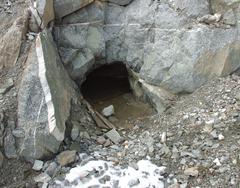
|

|
One of the difficulties is that alpine-type fissures are often not associated with striking geological features in the landscape, like a big vein or an obvious zonation around a pegmatite. They are simply to small to influence the morphology of the surrounding rocks in a way that would make their presence obvious from a distance. To find them, you have to patiently walk along the rocks. They often appear to be randomly distributed in a homogeneously formed rock[6.1]. A pocket might be just half a meter away inside the rock but someone not acquainted with the art of Strahlen would not note anything special[6.2]. The signs that lead one to a pocket are numerous, but rather subtle, and are not the same in all the different host rocks. So one needs a lot of patience and experience to find an alpine-type fissure and even more energy to open one. If someone inexperienced on a rockhounding trip to the Alps simply follows the well-known "good signs" for alpine-type fissures in an area that is reachable with the physical condition of an office employee, he will likely find only emptied pockets.
The following story might give you an idea of the skills of Strahlers: in 2003 I and a group of other rock hounds were attending a guided tour in the Feldbachtal, a side valley of the Binntal, Switzerland. At the end of the day, we and one of our guides, Ruedi, were heading back to our camp to meet the others for dinner. We were quickly walking down a slope covered by rubble, dirt and a little vegetation. Suddenly Ruedi stopped and took out his pick. We couldn't see anything suspicious, but he showed us a narrow band in the dirt that was a bit more yellow and started to dig into the ground. Two minutes later he had pulled several rock crystal groups out of a pocket that none of us would have found.

|

|
Footnotes
6.1 Earlier I have pointed out that alpine-type fissures often occur in groups and are associated with zones of stretching, but this is not so easy to see on a jagged rock wall.6.2 Which is not to say that I am acquainted with the art of Strahlen. I am slowly getting better at it, but I have very little practical experience.
 Printer Friendly Version
Printer Friendly VersionCopyright © 2005-2013, A.C. A k h a v a n
Impressum - Source: http://www.quartzpage.de/atf.html

